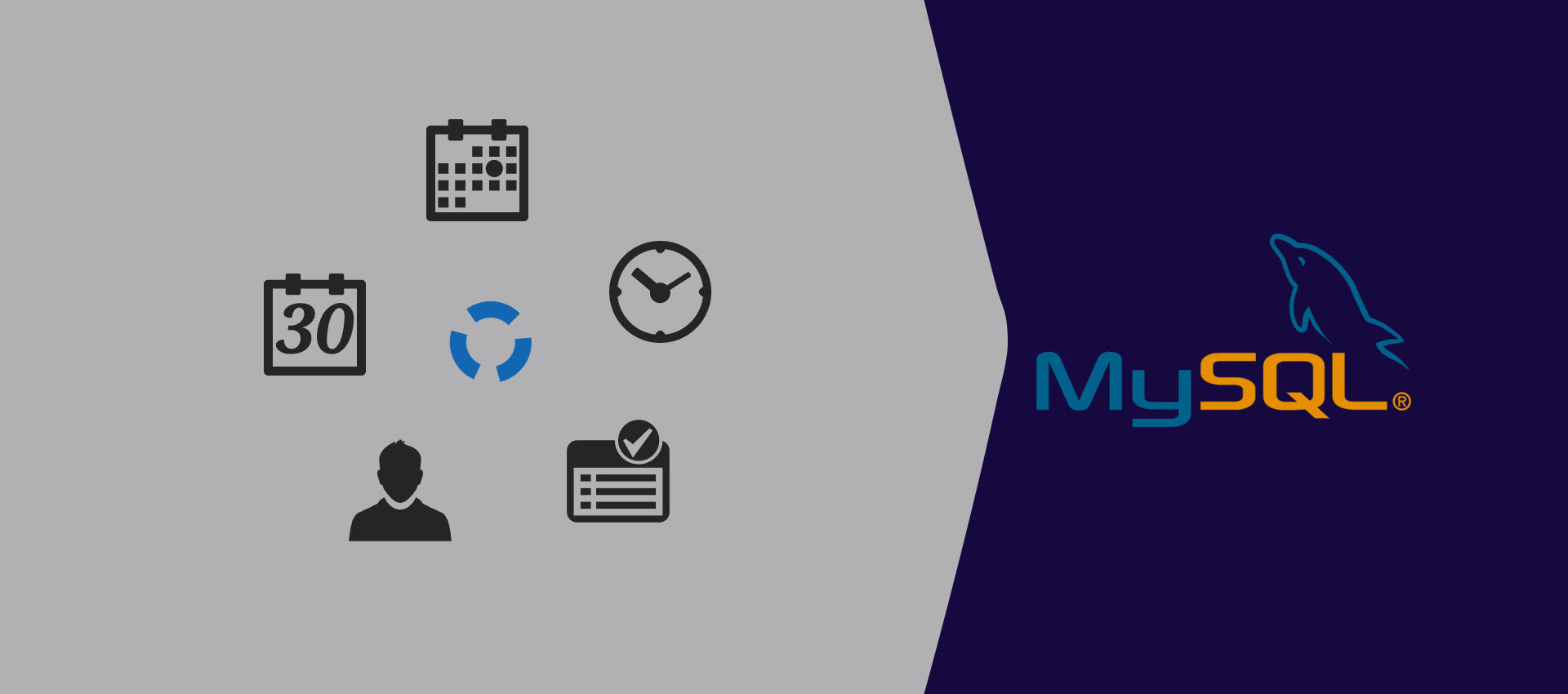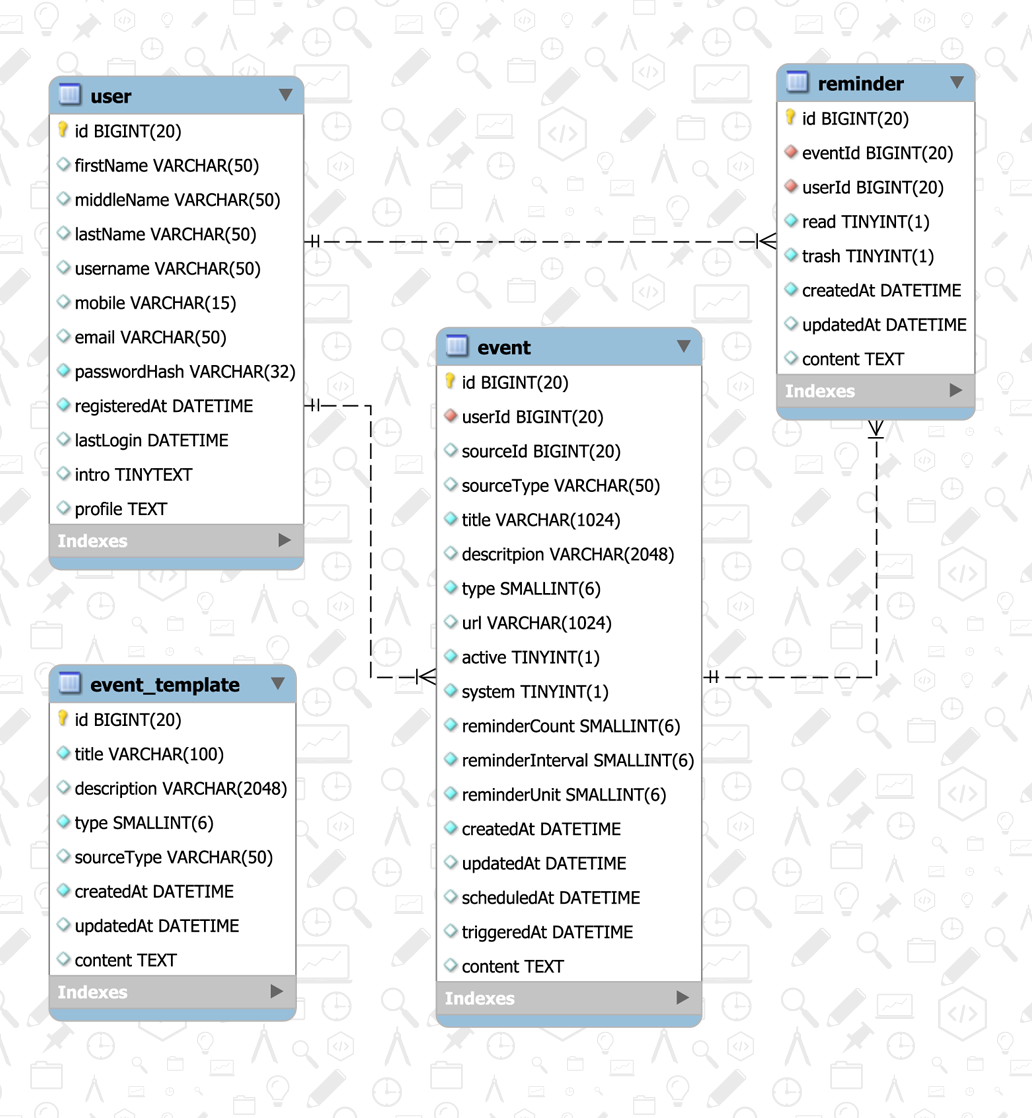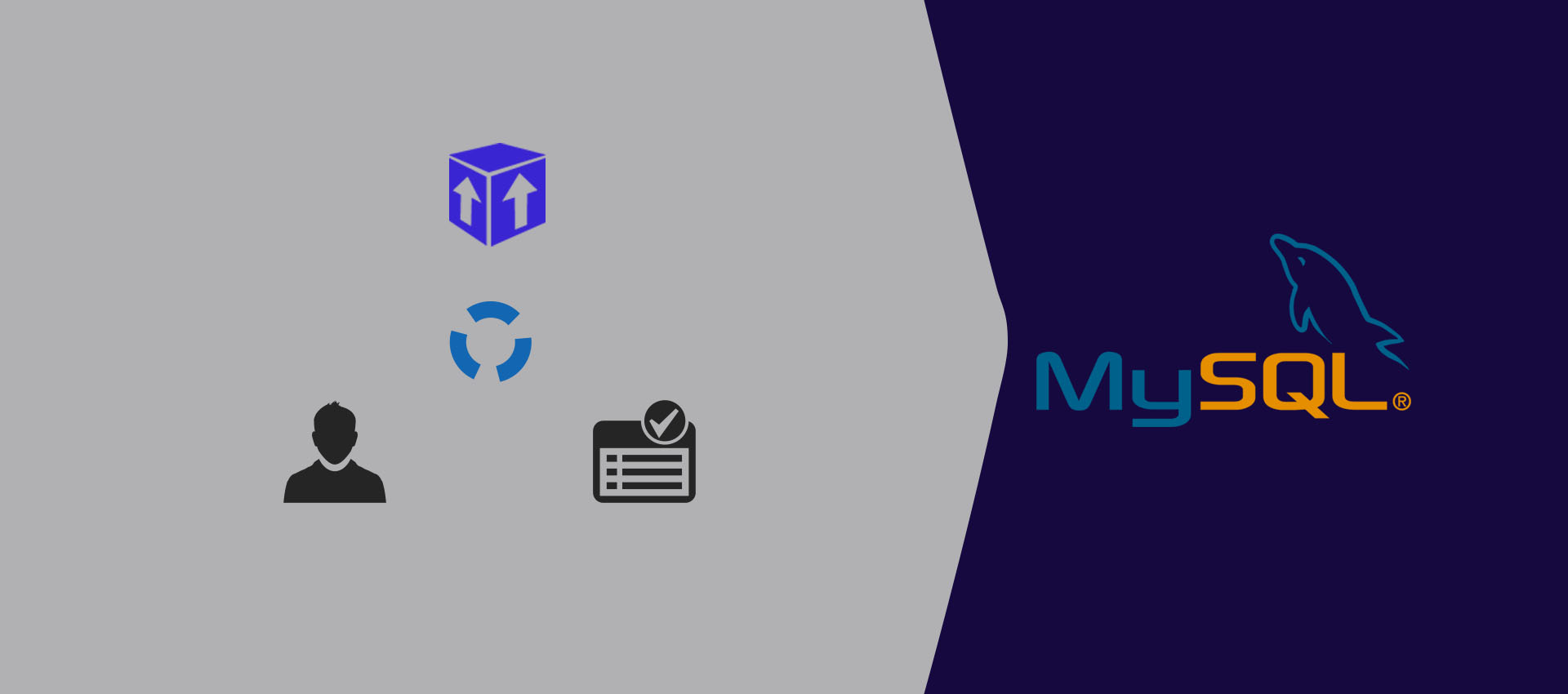
Guide To Design Database For Calendar Event And Reminder In MySQL
A complete guide to designing a database in MySQL for a simplified calendar events and reminders system. It shows how to design the database to store calendar events and reminders.
This tutorial provides the complete steps to design a database schema of the Calendar Event and Reminder System to manage the calendar events of the users and also store the reminders. It can be further enhanced and used to manage the events and reminders of other entities apart from the system user.
The Entity Relationship Diagram or visual database design is shown below.

Calendar Event and Reminder Database Design
You can also visit the popular tutorials including How To Install MySQL 8 on Ubuntu 20.04 LTS, How To Install MySQL 8 on Windows, How To Install MySQL Workbench On Ubuntu, How To Install MySQL 8 With Workbench On Windows 10, RBAC Database in MySql, Blog Database in MySql, Quiz Database in MySQL, Poll & Survey Database in MySQL, Online Shopping Cart Database in MySQL, and Learn Basic SQL Queries In MySQL.
Calendar Database
The very first step is to create the Calendar Database. It can be created using the query as shown below.
CREATE SCHEMA `calendar` DEFAULT CHARACTER SET utf8mb4 COLLATE utf8mb4_unicode_ci;
I have used the character set utf8mb4 to support a wide range of characters.
User Table
In this section, we will design the User Table to store user information. Users can manage their own events and reminders. Below mentioned is the description of all the columns of the User Table.
| Id | The unique id to identify the user. |
| First Name | The first name of the user. |
| Middle Name | The middle name of the user. |
| Last Name | The last name of the user. |
| Mobile | The mobile number of the user. It can be used for login and registration purposes. |
| The email of the user. It can be used for login and registration purposes. | |
| Password Hash | The password hash generated by the appropriate algorithm. We must avoid storing plain or encrypted passwords. |
| Registered At | This column can be used to calculate the life of the user with the application. |
| Last Login | It can be used to identify the last login of the user. |
| Intro | The brief introduction of the User. |
| Profile | User details. |
The User Table with the appropriate constraints is shown below.
CREATE TABLE `calendar`.`user` (
`id` BIGINT NOT NULL AUTO_INCREMENT,
`firstName` VARCHAR(50) NULL DEFAULT NULL,
`middleName` VARCHAR(50) NULL DEFAULT NULL,
`lastName` VARCHAR(50) NULL DEFAULT NULL,
`username` VARCHAR(50) NULL DEFAULT NULL,
`mobile` VARCHAR(15) NULL,
`email` VARCHAR(50) NULL,
`passwordHash` VARCHAR(32) NOT NULL,
`registeredAt` DATETIME NOT NULL,
`lastLogin` DATETIME NULL DEFAULT NULL,
`intro` TINYTEXT NULL DEFAULT NULL,
`profile` TEXT NULL DEFAULT NULL,
PRIMARY KEY (`id`),
UNIQUE INDEX `uq_username` (`username` ASC),
UNIQUE INDEX `uq_mobile` (`mobile` ASC),
UNIQUE INDEX `uq_email` (`email` ASC) );
Event Table
In this section, we will design the Event Table to store the user events and the events triggered by the application. Below mentioned is the description of all the columns of the Event Table.
| Id | The unique id to identify the event. |
| User Id | The user id to identify the corresponding user. |
| Source Id | The source id to identify the corresponding entity. |
| Source Type | The source type to distinguish the corresponding entity among other entities. |
| Title | The event title. |
| Description | The event description to store the key highlights of the event. |
| Type | The type to distinguish between the different event types. |
| URL | The URL to redirect the user to a specific link associated with the event. |
| Active | Flag to identify whether the event is active and eligible to be displayed on the calendar. |
| System | Flag to identify whether the event is generated by the application. The application events will always be eligible to be displayed on the calendar. |
| Reminder Count | The maximum number of reminders that can be triggered for the event. |
| Reminder Interval | The reminder interval. |
| Reminder Unit | The reminder unit to identify the reminder interval in minutes, hours, or days. |
| Created At | It stores the date and time at which the event is created. |
| Updated At | It stores the date and time at which the event is updated. |
| Scheduled At | It stores the date and time on the Calendar. |
| Triggered At | It stores the date and time at which the event was triggered. |
| Content | The column used to store the event content. |
It uses the column Active to identify whether the user-generated event can be displayed on the calendar. The System flag can be used to mark the application-generated events. The application-generated events can always be displayed on the calendar. The columns Source Id and Source Type can be used to identify the other tables or entities associated with the event. The column Triggered At stores the date and time at which the event was last triggered. The Event Table with the appropriate constraints is shown below.
CREATE TABLE `calendar`.`event` (
`id` BIGINT NOT NULL AUTO_INCREMENT,
`userId` BIGINT NOT NULL,
`sourceId` BIGINT,
`sourceType` VARCHAR(50) NULL DEFAULT NULL,
`title` VARCHAR(1024) NOT NULL,
`descritpion` VARCHAR(2048) NULL DEFAULT NULL,
`type` SMALLINT(6) NOT NULL DEFAULT 0,
`url` VARCHAR(1024) NULL DEFAULT NULL,
`active` TINYINT(1) NOT NULL DEFAULT 0,
`system` TINYINT(1) NOT NULL DEFAULT 0,
`reminderCount` SMALLINT(6) NOT NULL DEFAULT 0,
`reminderInterval` SMALLINT(6) NOT NULL DEFAULT 0,
`reminderUnit` SMALLINT(6) NOT NULL DEFAULT 0,
`createdAt` DATETIME NOT NULL,
`updatedAt` DATETIME NULL DEFAULT NULL,
`scheduledAt` DATETIME NULL DEFAULT NULL,
`triggeredAt` DATETIME NULL DEFAULT NULL,
`content` TEXT NULL DEFAULT NULL,
PRIMARY KEY (`id`),
INDEX `idx_event_user` (`userId` ASC),
CONSTRAINT `fk_event_user`
FOREIGN KEY (`userId`)
REFERENCES `calendar`.`user` (`id`)
ON DELETE NO ACTION
ON UPDATE NO ACTION);
Event Template Table
In this section, we will design the Event Template Table used to generate the event content. The application can further use the appropriate template system to parse the template to generate the event content. Below mentioned is the description of all the columns of the Event Template Table.
| Id | The unique id to identify the event template. |
| Title | The template title. |
| Description | The template description. |
| Type | The type to classify the templates. |
| Source Type | The source type to classify the templates according to the source type. |
| Created At | It stores the date and time at which the template was created. |
| Updated At | It stores the date and time at which the template was updated. |
| Content | The column used to store the template content. |
The Event Template Table with the appropriate constraints is as shown below.
CREATE TABLE `calendar`.`event_template` (
`id` BIGINT NOT NULL AUTO_INCREMENT,
`title` VARCHAR(100) NOT NULL,
`description` VARCHAR(2048) NULL DEFAULT NULL,
`type` SMALLINT(6) NOT NULL DEFAULT 0,
`sourceType` VARCHAR(50) NULL DEFAULT NULL,
`createdAt` DATETIME NOT NULL,
`updatedAt` DATETIME NULL DEFAULT NULL,
`content` TEXT NULL DEFAULT NULL,
PRIMARY KEY (`id`) );
Reminder Table
We also need a table to store the reminders triggered by active or system events. This section provides the table and columns required to manage the reminders. Below mentioned is the description of all the columns of the Reminder Table.
| Id | The unique id to identify the reminder. |
| Event Id | The event id to identify the event associated with the reminder. |
| User Id | The user id to identify the user associated with the reminder. |
| Read | The flag to mark the reminder as read/unread. |
| Trash | The flag to mark the reminder as trash. |
| Created At | It stores the date and time at which the reminder is created. |
| Updated At | It stores the date and time at which the reminder is updated. |
| Content | The reminder message. |
The Reminder Table with the appropriate constraints is as shown below.
CREATE TABLE `calendar`.`reminder` (
`id` BIGINT NOT NULL AUTO_INCREMENT,
`eventId` BIGINT NOT NULL,
`userId` BIGINT NOT NULL,
`read` TINYINT(1) NOT NULL DEFAULT 1,
`trash` TINYINT(1) NOT NULL DEFAULT 1,
`createdAt` DATETIME NOT NULL,
`updatedAt` DATETIME NULL DEFAULT NULL,
`content` TEXT NULL DEFAULT NULL,
PRIMARY KEY (`id`),
INDEX `idx_reminder_event` (`eventId` ASC),
CONSTRAINT `fk_reminder_event`
FOREIGN KEY (`eventId`)
REFERENCES `calendar`.`event` (`id`)
ON DELETE NO ACTION
ON UPDATE NO ACTION);
ALTER TABLE `calendar`.`reminder`
ADD INDEX `idx_reminder_user` (`userId` ASC);
ALTER TABLE `calendar`.`reminder`
ADD CONSTRAINT `fk_reminder_user`
FOREIGN KEY (`userId`)
REFERENCES `calendar`.`user` (`id`)
ON DELETE NO ACTION
ON UPDATE NO ACTION;
Enhancements
We can also manage group events using the same database schema. It can be done by adding the group flag to the event table and a new table is required to manage the participants of the group event.
Summary
In this tutorial, we have discussed the database design of a Calendar System to store user events and reminders. It also provided the database design to manage the user events triggered by the systems or application.
You may submit your comments to join the discussion. You may also be interested in designing the database of the Blog and Poll & Survey applications. The complete database schema is also available on GitHub.






